Each June this enterprising organization can be counted upon to reliably
serve up a winning mix of re-imagined classics, world or national premiere
productions, stellar musical comedies or operetta, and a roster of singers,
conductors, and designers that should be the envy of many a major international
house.
I know it can be a bore to hear someone say “well. . .I saw the original
production.” (Indeed, that is seldom heard in opera circles, so bear with
me.) As a matter of fact I did encounter the brilliant Hal Prince-directed
Sweeney Todd when first on Broadway, red hot from its multiple Tony
wins with two of musical theatre’s legendary performances from Angela
Lansbury and Len Cariou. You might think it can’t get any better than that,
right? Well, you would be wrong!
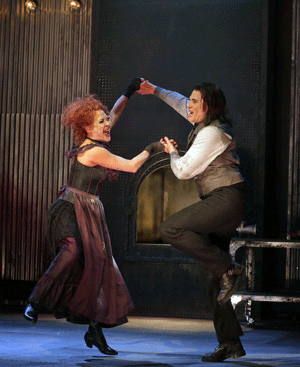 (L to R) Karen Ziemba as Mrs. Lovett and Rod Gilfry as Sweeney Todd
(L to R) Karen Ziemba as Mrs. Lovett and Rod Gilfry as Sweeney Todd
For OTSL has assembled as fine a cast for the Sondheim opus as is likely
available today, and has placed them in a broodingly clever minimalist
environs. Karen Ziemba is perfection as Mrs. Lovett, embodying the character
with a truly unique sexiness, spunky child-like determination, and spot-on
comic timing. Having admired Ms. Ziemba for years as a Broadway triple threat
(Crazy for You, Curtains, Steel Pier) nothing in her past work could
have prepared me for the depth, variety, and invention she brought to Nellie
Lovett. Plus she has the chops to really sing the rangy part from the rolling
chest voice to the fluty soprano flights that were written to Ms. Lansbury’s
singular gifts. It is to her great credit that Karen emphatically makes the
part her own, and along the way makes the demented, codependent love story and
physical attraction really take flight.
Not that it is hard to imagine being physically attracted to Rod Gilfry’s
barber, since he cuts a fine figure, even as he is revealed to be housing an
intensely coiled, vengeful spirit. This is arguably the finest performance I
have seen from Mr. Gilfry to date. His compact baritone managed to encompass
the punishing demands of even St. Stephen’s most challenging writing, and
while I have often heard him sing more suavely, never have I heard him sing
more purposefully. Not once did he revert to flashing his generic, killer, Brad
Pitt smile that seemed to define (and limit) his whole performance as last
summer’s Glimmerglass Frank Butler. On this occasion he was nuanced,
detailed, and frighteningly focused on his mission.
Arguably, the star vocal honors belonged to Nathaniel Hackmann’s superbly
sung Anthony. The rich and ringing tone he brought to his paean to Joanna, the
impassioned youthful spirits, the beautiful control on the hushed declarations
of love, Mr. Hackmann regaled us with ravishing vocalism of the top tier. Add
to the mix the fact that he is boyishly appealing, and you have, well, a
definitive performance of the plucky lad (pace, Victor Garber). His
accomplishment was ably matched by the enchanting chirping from his Joanna,
Deanna Breiwick, who deployed her fluty, well schooled soprano to fine effect
in Green Finch and Linnet Bird.
In a bit of luxury casting, acclaimed mezzo Susanne Mentzer made the most of
her vibrant upper register and solid low tones to create an exceptionally wiry,
aggressive Beggar Woman. Her physical abandon in defining the schizophrenic
street person, combined with her vivid singing made this a memorable role
assumption. Veteran Timothy Nolen struck just the right balance as the
malevolent Judge Turpin, offering an understated model of control at one
moment, and erupting with abusive authority the next. His compact baritone was
put to good effect in the problematic Deliver Me, a rambling
masochistic titillation which plays only marginally better in the opera house
than on Broadway (where it was cut before the show opened).
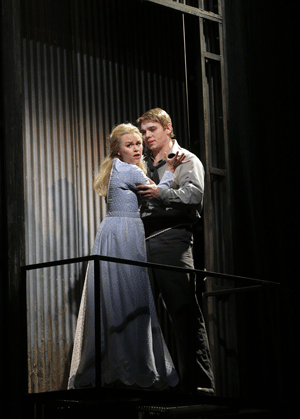 (L to R) Deanna Breiwick as Johanna and Nathaniel Hackmann as Anthony Hope
(L to R) Deanna Breiwick as Johanna and Nathaniel Hackmann as Anthony Hope
Scott Ramsay sang a wondrously secure Beadle Bamford. He was a good physical
type to boot, if a bit too young for the character’s history. But the
trade-off is that there is a freshness, clarity and bloom in Mr. Ramsay’s
tenor that are enormously pleasing. The repeated falsetto’d “Ding
Dong’s” in his parlor duet with Mrs. Lovett caused a ripple of delight in
the audience.
Anthony Webb was also a mite too young to have fully lived the checkered
past of Signor Pirelli, however, his skillful comic “Italian” accent and
gleaming high notes gave much pleasure. Last but not least, Kyle Erdos-Knapp
gave the kind of masterful performance as Tobias against which all future
interpretations should be measured. After good duty with the (too) lengthy
introduction for Pirelli, and then the sprightly contributions to God,
That’s Good, Mr. Erdos-Knapp came into his own with a fully-realized
rendition of Not While I’m Around. Here his attractive, confident
lyric tenor proved a perfect match for the arching lines and soaring heights of
the score’s best tune. We scarcely dared breathe as Kyle spun out
‘pianissimo’ musings of aching beauty. And he acts, too!
With Stephen Lord holding the baton, the Sondheim score (and Jonathan
Tunick’s brilliant orchestrations) has never sounded better. However, since
the decision was made to mike the singers, I do wish they had gone all the
(Broad)way and done the same for the orchestra so the music shared the same
‘presence’ in the house. Final musical kudos go to the always commendable
Gerdine Young Artists who formed the chorus and so effectively communicated the
many tricky solo lines in the ensemble writing.
Without getting ahead of myself (but not wishing to repeat myself over four
different productions), lighting designer Christopher Akerlind is a company
treasure. His work on Sweeney was nothing short of brilliant (pun
intended). The moody, menacing washes; the accurate tight specials; the roving
spots; the uses of silhouette and back-lighting; the skill in keeping the
soloists’ faces illuminated; the apt selection of color filters and gobos;
this was a Masters’ Class in Excellence in Stage Lighting. And he repeated
his complete success in all the other three productions this season. Bravo, Mr.
Akerlind.
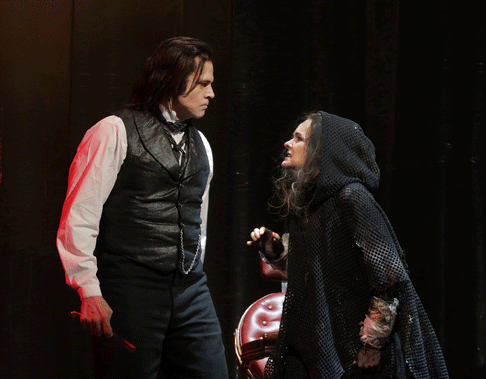 Rod Gilfry as Sweeney Todd and Susanne Mentzer as the Beggar Woman
Rod Gilfry as Sweeney Todd and Susanne Mentzer as the Beggar Woman
The entire physical production provided an artistically gritty environment,
a visual realization of the de-humanizing effects of the Industrial Revolution,
and disturbing parallel to the blackness of men’s souls. Riccardo
Hernandez’s unit of corroding factory walls, dotted with bleak industrial
lights, formed the basic playing space. With the addition of carefully chosen,
highly specific set pieces, every locale was aptly suggested with great
economy. Especially effective was the mid-stage, textured plastic curtain,
edged with splotches of ‘blood,’ that was backlit. This imparted a surreal
chiaroscuro scrim effect to such enactments as Lucy’s rape at the ball, and
Joanna’s rescue from the asylum, among others.
Emily Rebholz contributed an array of appropriate costumes, from the raggedy
street people, to the fading finery of the working middle class, to the richly
appointed upper crust. For the Pirelli gathering as well as the asylum inmates,
she has crafted giddily bizarre suggestions of an Edward Gorey fashion plate.
Ron Daniels‘ direction revealed meaningful character relationships through
layered subtext and well-motivated blocking. His pointed use of the (Greek)
chorus was blessedly unfussy. Perhaps his greatest success was in mining every
last bit of humor from the grim tale and for creating a real physical
relationship between his two protagonists. It has taken over thirty years, but
for me here at last was a “Sweeney Todd” not only equaling the original,
but in many ways surpassing it.
Lightening struck again the next night with the very best production of
Cosi fan Tutte I have ever seen. Yes, ever. I will effuse momentarily
about the uniformly splendid cast but first, the over-riding triumph here was
the flawless direction from Michael Shell.
Mr. Shell not only found fresh ways to make the ‘usual’ schtick land
(read: Despina’s and the boys’ disguises) but infused the first act with so
many delightful comic surprises that the piece actually seemed new again. Have
you ever laughed out loud at the soprano’s comic touches during Come
scoglio? Ever? I certainly hadn’t. Yet there was Miss Miffed Thing,
using the music’s scored dynamics to calculate over-reacting outbursts which
make us giggle at, well, just how silly it really all is.
Similarly, Dorabella mined a wealth of giddy girlish faux protestations as
she contemplated, and then munched, a cookie through half of Smania
implacabile. (Despair? Maybe. . .oh-wait-there’s-food. . .) No clichÈd
oversize magnet for Dr. Despina in this version, nope, but rather a copper
saucepan that she “rang” with a spoon like at a shivaree.
This interpretation also contained unambiguous sexual interplay with no
doubt that the disguised suitors were out for instant gratification. One of the
best (low) laughs of the night occurred when the guests first arrived and
proffered “gifts” to the maidens. Held just below waist level, cloths that
were covering the presents were whisked away in unison to reveal matching
potted plants, each with a big pink cone-like flower protrusion just at the
right ‘anatomical position.’ Mozart would have loved this. (And if he
didn’t, to hell with him.)
Mr. Shell did let things settle down in Act II of course, and the
seriousness and despair that set in were all the more profound for the romping
fun that preceded it. Ditsy Dorabella goes with the flow but Fiordiligi cannot
relinquish her feelings of betrayal, and at the finale she ultimately breaks
from her ‘assigned’ lover to isolate herself center stage, confused and
indecisive, an ingenious, plausible, and thought-provoking twist to the usual
pat ending.
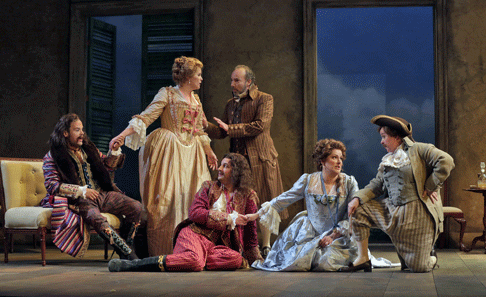 (L to R) David Portillo as Ferrando, Rachel Willis-S¯rensen as Fiordiligi, James Maddalena as Don Alfonso, Liam Bonner as Guglielmo, Kathryn Leemhuis as Dorabella, and Jennifer Aylmer as Despina
(L to R) David Portillo as Ferrando, Rachel Willis-S¯rensen as Fiordiligi, James Maddalena as Don Alfonso, Liam Bonner as Guglielmo, Kathryn Leemhuis as Dorabella, and Jennifer Aylmer as Despina
James Schuette has designed sumptuous period gowns for the two female
lovers, eye-catching uniforms and exuberant ‘disguises’ for the two men,
and elegantly functional period dress for everyone else. Doing double duty,
Schuette’s handsome unit set becomes a multi-purpose drawing room, tavern,
and garden as required, simply accessorized with chandeliers, plants, tables,
and/or settees. The handsome wigs and lovely make-up were by Ashley Ryan.
Rachel Willis-S¯rensen proved a radiant Fiordiligi, blond and imposing in
stature, with an ideal Mozartean musical sensibility. Her heavy lyric voice has
spinto leanings and the thrilling intensity in her top notes was matched by an
even, creamy legato that encompassed the role’s considerable range. Ms.
Willis-S¯rensen‘s coloratura work was sprightly and accurate, her floated
piano singing limpid and affecting, her dramatic outbursts focused and
controlled. As an actress, Rachel took us on a complicated journey from defiant
girlish loyalty, through weakening resolve, to profound doubt, to the depths of
passion, to the end point of astonished betrayal. Quite a profound arc for a
three hour opera!
No less detailed was the feckless, fickle Dorabella presented by Kathryn
Leemhuis. I greatly admired Ms. Leemhuis‘s cheeky Zerlina in last summers
Giovanni and she brought an even greater comic sensibility and
emotional spontaneity to Cosi. As she reveled in her indecision, and
demurely blew off the consequences of her actions, she also sang the part with
utter confidence and a velvety mezzo that blended perfectly with her
“sister.” The numerous melismatic passages sung in thirds by the duo were
consistently, sinuously bewitching.
Jennifer Aylmer proved to be an unusually ripe-voiced Despina. Not merely a
sassy, piping coquette, she; but rather a seasoned party girl with a vibrant,
forthcoming, rock solid soprano. Ms. Aylmer‘s affected voices for the doctor
(mock Yiddish) and the lawyer (sinus sufferer) were both well sustained and
well considered, especially as she married them to the execution of some
inspired, goofy physicality.
David Portillo and Liam Bonner were ideally cast as Ferrando and Guglielmo.
The short/cute Mr. Petrillo and the lanky/dashing Mr. Bonner were an 18th
Century Mutt and Jeff, making for many good contrasts and humorous
interactions. David is possessed of a meltingly attractive lyric tenor, fresh,
youthful, and pliant. The beautiful repose of his crystalline Un’ aura
amorosa was one of the evening’s highlights, in a night that was crowded
with musical excellence. Liam married a peacock’s vanity to a rooster’s
strut, and conquered the part with a virile, responsive baritone of
considerable power and thrust. His egocentric take on the soldier drove the
action (and reactions) to good effect.
In the key role of Don Alfonso, it was a pleasure to once again encounter
veteran James Maddalena, who has happily been a constant presence on the opera
scene for over thirty-five years. His intelligent music-making and
well-considerd acting were always in evidence. While I can’t report that his
sturdy baritone is as fresh and responsive as it was thirty-five years ago, at
this point in his career the instrument has compensated by assuming a warm,
pleasingly grainy patina. As Cosi’s puppet master, he brings an
assured and commanding presence to Alfonso’s machinations.
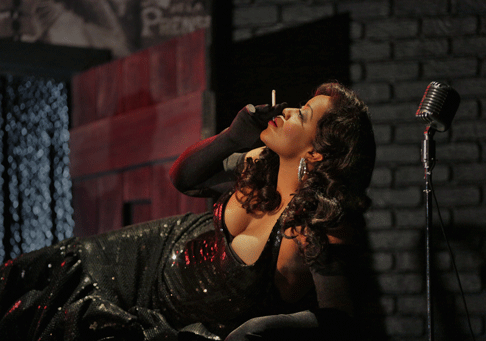 Kendall Gladen as Carmen
Kendall Gladen as Carmen
Jean-Marie Zeitouni not only led a taut, stylistically sound reading in the
pit, but presided over a meticulously paced performance that never once allowed
ser pieces to descend into self-pity or bathos. Never have I experienced a
Cosi that unfolded so inevitably. This is not to suggest that the
Maestro was all impetuosity and rushed dramatic gestures. The overall intensity
of the forward motion was relaxed as merited to relish introspective watershed
moments, that were made all the more effective for the change of pace.
OTSL’s other “standard fare” was the evergreen “bread and butter”
favorite, Carmen. Director Stephen Barlow has re-imaged the classic as
a ‘film noire’ and much of the concept reaped good dividends. Having a
black and white old-time film projection of production credits during the
prelude was a clever touch, and following it with a flash-forward of Jose
getting arrested as Carmen’s body is carried away on a stretcher (leaving a
white chalk outline on the ground) really established the genre (with a wink to
Sunset Boulevard). So far so good.
But the plot points began to unravel quite quickly when there were no
soldiers, but rather only a handful of policemen in a vacant lot in 1940’s
Seville, backed by a cyclone fence upstage, in front of which was an
indeterminate platform affixed with a billboard bearing an image of Carmen.
Making JosÈ a police sergeant doesn’t quite work, and having the ragamuffin
boys’ chorus be turned into Catholic schoolgirls playing hopscotch just
doesn’t mesh with their singing of “playing soldier.”
I was bowled over by Paul Edwards’ stunning black and white period
costumes. The scope, diversity, and sheer numbers of different looks created a
movie-glamorous version of Spanish life. Would that his scenery had been as
thorough or as imaginative. Lillas Pastia’s tavern made use of the same up
center platform as Act One, with the addition of an upright piano and a beaded
doorway stage left, a scattering of some tables and chairs, and a massive
collage hanging up left center fronted by a neon “Pastia’s” sign.
For Act Three’s mountain pass, after a considerable pause to “change the
set,” we were still in the same setting minus the piano and a few tables and
chairs, and with the neon sign turned off but still discernible. Hmmm. For the
street procession outside Act Four’s bull ring, we were back to the exact
same setting as Act One, where the cigarette factory had been established as
off up right. So. . .where was the bull ring? I guess, off left? With the
entire visual effect quite meticulously contrived to be black and white, why
choose to have Carmen’s Jimmy Choo’s be red? And why the red neon sign? And
the red flower? Nothing in Act Four was red. The inconsistency and choices of
these few uses of this one primary color was puzzling.
The floor plan also contributed to some blocking oddities. After the
cigarette girls all entered up right behind the fence and established a traffic
pattern around the full length of the fence to wind around it up left and spill
into the main playing space, Carmen appears with them, and then enters on the
platform, sidling around from behind the billboard. Is there a fence or not?
And if not, why don’t some of the girls take a shorter path to the square?
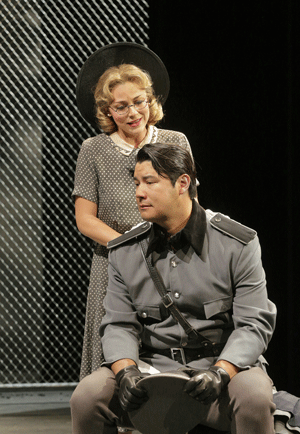 (L to R) Corinne Winters as MicaÎla and Adam Diegel as Don JosÈ
(L to R) Corinne Winters as MicaÎla and Adam Diegel as Don JosÈ
Okay, Mr. Barlow is trying to give her a star entrance, but it should make
sense. He has created a number of nice stage pictures but has not always
bothered to motivate movement. Why have MicaÎla and JosÈ suddenly part down
center only to re-position the girl right of the platform and him center of it
just so she can cross back to him? Why have our Diva start Les tringles des
sistres tintaient lounging atop the piano and work her way center, only to
return her afterwards to her perch at the weakest visual position on the
stage?
Other ideas scored big, like having Carmen and Escamillo driven on at the
end of the parade seated atop a convertible, amidst a shower of glittering
confetti from the flies. And, having JosÈ brutally and abruptly kill Zuniga, a
premonition of his calculated execution of Carmen, shooting her even as he
kisses and caresses her. And, devising real sexual menace in MicaÎla’s first
encounter with the townsmen. There is no question Mr. Barlow has manufactured
some potent moments, even though has not yet knit all of his ideas into a
unified whole.
Barlow is also credited with having created “new dialogues” to supplant
Amanda Holden’s English translation. I am not sure the dramatic intent is
well-served by intermittent insertion of Spanish words. As the tenor utters
self-conscious phrases like “Tell me about mi madre” it seems like
we are experiencing Berlitz-for-the-Clinically-Bewildered. Perhaps the overall
stilted delivery of spoken lines was intended to evoke a film style but it must
be said that the performers almost seemed to lose character when they stopped
singing and started speaking.
Adam Diegel’s otherwise admirable JosÈ was perhaps most handicapped by
his script. Having enjoyed Mr. Diegel in the past, it is a pleasure to note how
much he has grown as an artist, even since last summer’s Glimmerglass
Carmen. The tenor still commands an impressive ping on the full-voiced
top notes, but has since begun to really explore more nuance and dramatic
colorings throughout his range. His vocal embodiment of the obsessed soldier
was now far more complete, with shadings and refinements that were wonderful to
observe.
Like with most other tenors in this role, I do wish he could find a way to
finesse the penultimate phrase in the Flower Song into a spun head voice, but
since he chose to “Sing Out, Louise” I can report that he nailed it with
controlled power. Adam has also learned to relax a bit more on stage, and there
were moments of engaging, boyish charm between him and MicaÎla. He could
improve his impression in this opera even more by surrendering to a more
passionate, sex-propelled hunger for the Bad Girl. Once this aspect of his
interpretation is mined further, he will truly be a talent to be reckoned with
in the part. Corinne Winters proved a memorable MicaÎla. Every inch the
darling “girl back home” (but did she need the bookish eyeglasses?) Ms.
Winters created the tale’s most sympathetic creature and sang with a refined,
glistening soprano that was especially luminous above the staff. The palette of
vocal colors in her arsenal greatly enhanced communication and projection,
especially the hint of round darkness in the lower range. Aleksey Bogdanov had
all the moxie needed to voice a preening, pompous Escamillo. His tightly
focused, riveting baritone made short work of the Toreador Song as
well as the Act Three confrontation. He was marginally less successful with the
gentler assertions of love in his final scene, for which his sizable instrument
proved a mite clumsy. Bradley Smoak made more of an impression as Zuniga than I
thought possible by affecting an authoritative presence, and singing powerfully
with a straight-forward, burnished baritone of considerable beauty.
Gerdine Artist, Hernan Berisso impressed with his solidly sung Morales, his
clean baritone and youthful demeanor making a substantial contribution. As
Frasquita and MercÈdËs, Jennifer Caraluzzi displayed a polished, soaring
soprano and Shirin Eskandani showed off a pleasing, pliant mezzo. Baritone
Thomas Gunther (Danca?ro) and tenor Michael Kuhn (Remendado) sang stylishly
and securely. These four young artists made the most of their showcase in the
famous quintet, although their scrubbed good lucks and well-tailored, sparkling
costumes did momentarily suggest cast members of “Glee” as they might
performGuys and Dolls. Never you mind, the success of these budding
performers (and let’s throw in Nikolas Wenzel’s animated Lillas Pastia)
demonstrates once again the importance and success of OTSL’s dynamic Gerdine
Young Artists training program.
If any further proof is needed, Kendall Gladen as Carmen is a joyous
“Local Girl Makes Good” story. Having been a former Gerdine Artist, the
native St. Louisian has returned home in triumph. Ms. Gladen has an uncommonly
rich, sonorous mezzo. Whether rising to the heights with ringing abandon, or
descending into a searing chest register, she not only thrills us with the
money notes but expertly blends her resources together for quite a seamless
traversal of one of opera’s most famous heroines. Kendall has also captured
the role’s (and I use the technical term here) Va-Va-Voom-Factor. She is
statuesque, alluring, womanly, and stage savvy to boot.
And she has a sense of humor about Miss Carmen that is often in short
supply, like when she calculatedly fluffs up her ta-ta’s in anticipation of
the bullfighter’s Act Three arrival. With this performance, Kendall Gladen
proved to be a beautiful, charismatic, vocally assured, musically gifted singer
who has served emphatic notice that she is more than ready to become the
world’s next “Carmen of Choice.”
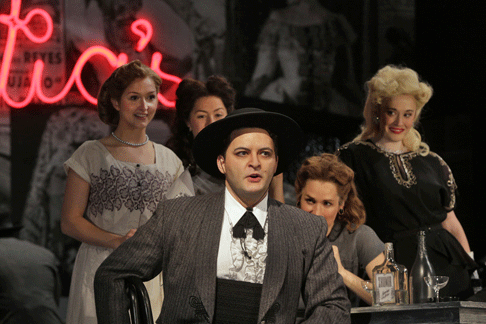 Aleksey Bogdanov as Escamillo
Aleksey Bogdanov as Escamillo
Maestro Carlos Izcaray kept everything moving along pleasantly in the pit,
proving to be a collegial partner to his talented cast. Here, as in the other
three works, Robert Ainsley’s well-tutored choral forces performed tightly,
responsively, and intelligibly.
OTSL is to be roundly cheered for being such a consistent champion of new
works. This summer brought the American premiere of Unsuk Chin’s Alice in
Wonderland to a libretto by David Henry Hwang (in collaboration with the
composer). As admirable as is this dedication to fostering new creations, it
also brings with it considerable risk. And I am sorry to report, that in this
case, the risk did not quite pay off.
First, the good news. Make that “great” news. The physical production
could not be bettered. This was OTSL at the top of its game. Set Designer Allen
Moyer has crafted a marvelous collection of rolling, oversized furniture that
twists, turns, opens and closes to create all manner of magical
transformations. James Schuette’s fanciful costumes include some of his
finest creations, and as already mentioned, Mr. Akerlind’s superb lighting
was at its most complex and most effective here. He was ably abetted by Greg
Emetaz’s strikingly imaginative video projections that advanced the story and
engaged our eye. Ms. Ryan went into overdrive and produced outlandish wigs and
a make-up design that were beyond ‘sensational.’ And James Robinson tied it
all up with a bow, directing a fantasy of incomparable invention with
meticulous management of the assembled forces.
In the title role, petite Ashley Emerson was everything you imagined Alice
should be, unleashing her slender, reliable soprano with aplomb. Tracy Dahl was
a lovable Cheshire Cat, and her coloratura flights of fancy were awesomely
accurate. In the dual roles of the White Rabbit and the March Hare, David
Trudgen displayed an impressive counter-tenor of true distinction. Jenni
Bank’s sturdy, characterful mezzo was well suited to the cheeky Duchess, and
Julie Makerov’s stentorian, steely soprano was a good match for the
domineering Queen of Hearts, while Bradley Smoak gave the night’s most varied
performance as the King. Matthew diBattista was lovably effective as the dozing
Dormouse. Perhaps the very finest vocal performance was given by Aubrey
Allicock as the Mad Hatter, his spirited bass-baritone ringing out with gusto.
There are far too many characters and fine accomplishments to mention but they
were all first rate. So what is the “Bad News,” you may wonder?
Unfortunately, Ms. Chin has composed a score that just does not “sing.”
To give her some due, there are many admirable orchestral colors, layers of
sound, and attempted pastiches or recollections of different styles (Baroque,
Bel Canto, Rap, etc.) but the writing sprawls and individual scenes wear out
their welcome by churning on long after we have gotten the point. Characters
are not adequately differentiated vocally, and there is not a ‘tune’ to be
found. Conductor Michael Christie works tirelessly, and the assembled forces
give it their all but. . .the closest thing to a successful moment is Alice’s
brief lullaby to the baby pig. That is because all at once the arioso seems to
want to please our ear rather than engage our intellect, and the brevity of the
scene focuses our attention. Sadly, that was one oasis in an overlong evening
of rambling aural inaccessibility.
I have seen too many Euro-trash productions to count, and at most of them I
wish I could (and sometimes do) just close my eyes and listen to the music. In
a turnabout, with Alice in Wonderland I wish I could have just watched
the lavish spectacle and turned off the sound. For all Alice’s
aspiration, hard work and promise, in the end we came out humming the
scenery.
James Sohre
Sweeney Todd
Sweeney Todd: Rod Gilfry; Anthony: Nathaniel Hackmann; Beggar Woman: Susanne
Mentzer; Mrs. Lovett: Karen Ziemba; Beadle Bamford: Scott Ramsay; Joanna:
Deanna Breiwick; Judge Turpin: Timothy Nolen; Tobias: Kyle Erdos-Knapp; Signor
Pirelli: Anthony Webb; Fogg: Marco Stefani; Conductor: Stephen Lord; Director:
Ron Daniels; Set Design: Riccardo Hernandez; Costume Design: Emily Rebholz;
Sound Design: Michael Hooker; Lighting Design: Christopher Akerlind; Wig and
Makeup Design: Ashley Ryan; Choreographer: Se·n Curran; Chorus Master: Robert
Ainsley
Cosi fan Tutte
Ferrando: David Portillo; Guglielmo: Liam Bonner; Don Alfonso: James
Maddalena; Fiordiligi: Rachel Willis-S¯rensen; Dorabella: Kathryn Leemhuis;
Despina: Jennifer Aylmer; Conductor: Jean-Marie Zeitouni; Director: Michael
Shell; Set and Costume Design: James Schuette; Lighting Design: Christopher
Akerlind; Wig and Makeup Design: Ashley Ryan; Choreographer: Se·n Curran;
Chorus Master: Robert Ainsley; Continuo: Fortepiano, Damien Francoeur-Krzyzek
and Violincello, Melisse Brooks
Carmen
Morales: Hernan Berisso; MicaÎla: Corinne Winters; Zuniga: Bradley Smoak;
Don JosÈ: Adam Diegel; Carmen: Kendall Gladen; MercÈdËs: Shirin Eskandani;
Frasquita: Jennifer Caraluzzi; Lillas Pastia: Nikolas Wenzel; Escamillo:
Aleksey Bogdanov; Danca?ro: Thomas Gunther; Remendado: Michael Kuhn;
Conductor: Carlos Iscaray; Director: Stephen Barlow; Set and Costume Design:
Paul Edwards; Lighting Design: Christopher Akerlind; Wig and Makeup Design:
Ashley Ryan; Chorus Master: Robert Ainsley
Alice in Wonderland
Alice: Ashley Emerson; Young Boy: Trevor Scott; White Rabbit/March Hare:
David Trudgen; Duck/Mad Hatter: Aubrey Allicock; Mouse/Dormouse/Invisible Man:
Matthew diBattista; Caterpillar: James Meyer, clarinetist and Se·n Curran,
dancer; Duchess: Jenni Bank; Cook: Ashley Logan; Cheshire Cat: Tracy Dahl;
Queen of Hearts: Julie Makerov; King of Hearts: Bradley Smoak; Conductor:
Michael Christie; Director: James Robinson; Set Design: Allen Moyer; Costume
Design: James Schuette; Video Design: Greg Emetaz; Lighting Design: Christopher
Akerlind; Wig and Makeup Design: Ashley Ryan; Choreographer: Se·n Curran;
Chorus Master: Robert Ainsley
image=http://www.operatoday.com/ALICE_9.gif
image_description=Ashley Emerson as Alice [Photo by Ken Howard courtesy of Opera Theatre of Saint Louis]
product=yes
product_title=Opera Theatre of Saint Louis 2012
product_by=
product_id=Above: Ashley Emerson as Alice
Photos by Ken Howard courtesy of Opera Theatre of Saint Louis